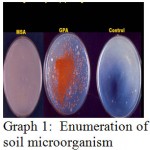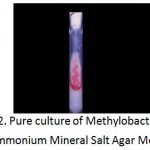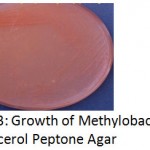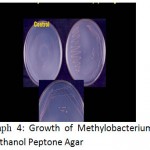How to Cite | Publication History | PlumX Article Matrix
Formulation of New Media for the Mass Production of Methylotrophs
S. Meenakumari1 and S. Ahmed John2
1Department of Biotechnology, N.M.S.SVN College (Autonomous), Madurai - 625 019 (India).
2Post Graduate and Research Department of Botany Jamal Mohammed College, Tiruchhirappalli - 620 020 (India).
ABSTRACT: Methylotrophs a group of organism, have the ability to oxidise C1 carbon compounds. This organism promotes the plant growth by producing plant growth hormones. So this organism can be used as bioinoculant to improve crop production. Mass production of Methylobacterium has some constraints. To overcome the problems existing during the mass production of Methylobacterium a new media is formulated with the contents of Methanol, Peptone, and Cycloheximide to prevent the fungal and bacterial contamination. These media favors the growth of effectively since it is a C1 utilizer.
KEYWORDS: C1 Carbon compounds; methylotrophs; methylobacterium; methanol; cycloheximide
Download this article as:| Copy the following to cite this article: Meenakumari S, John S. A. Formulation of New Media for the Mass Production of Methylotrophs. Biosci Biotech Res Asia 2010;7(2) |
| Copy the following to cite this URL: Meenakumari S, John S. A. Formulation of New Media for the Mass Production of Methylotrophs. Biosci Biotech Res Asia 2010;7(2). Available from:http://www.biotech- asia.org/?p=9810 |
Introduction
Methylotrophy is the capacity to aerobically utilize single carbon (C1) compounds as a source of carbon and energy in three stages like oxidation of C1 compounds to Formaldehyde in to biomass.Methylotrophs are the organisms which involve in Methylotrophy (Kalyarvae et al, 2001). Obligate methylotrophs grow only on methane or methanol (Foster, 1966). These organism use one of two pathways to assimilate compounds either the serine pathway (Hamptinstall, 1970) or the ribulose phosphate cycle to build cell biomass (Stolyar, 1999 and 2001). The first enzyme in this pathway is a mixed function oxidase called methane monooxygenase (Colby, 1985).The ubiquitous nature of methylotrophs were described by Green and Bousefeild in 1989. They found methylotrophs in soil and on surfaces of leaves and other plant parts. Methylotrophs were first isolated by Austin and Goodfellow in 1970. Because of its agriculture importance, the mass production of the organism was carried out in Glycerol peptone agar. These organism actively participate in plant growth promotion by producing growth hormones like Auxin (Corpe, 1985)
Materials and Methods
Sample was collected from paddy field and it was serially diluted using Methanol Salt Agar. Colonies were isolated based on their morphological characters. Pure culturing was performed using Ammonium Mineral Salt Medium. Mass production of the organism was first initiated with Glycerol Peptone Agar. Then mass production was done using Methanol Peptone Agar.
 |
Plate 1: Enumeration of soil microorganism.
|
 |
Plate 2: Pure culture of Methylobacterium in Ammonium Mineral Salt Agar Medium.
|
 |
Plate 3: Growth of Methylobacterium in Glycerol Peptone Agar.
|
 |
Plate 4: Growth of Methylobacterium in Methanol Peptone Agar.
|
Results and Discussion
Serially diluted samples were analyzed for morphological characterization. Initial characterization was performed with Methanol Salt Agar (Plate-1) because soil contain diverse group of microorganism when it is serially diluted, supported all group of microorganism if it serially diluted with Nutrient agar medium since Nutrient medium is a complex medium. Isolated colonies in methanol salt agar were then pure cultured in Ammonium Mineral Salt Medium (Plate-2). This medium limits the growth of Methylobacterium. Methylobacterium is a best inoculants for crop production. But the mass production for bioinoculant preparation failed to better result in the presence of Glycerol Peptone Agar (Plate-3). Because glycerol served as good substrate for fungus. The media used for mass production was found suitable for fungal growth. So another new media was required for the mass production of the culture. The new medium Methanol peptone Agar formulated exclusively for Methylotrophs (Plate-4). Methanol in the medium is utilized by the inoculated organism and also it limits the growth of other bacterium. Peptone served as protein source for the growing microorganism. The preparation and the sterilization of the medium are very easy. No contamination found in during the course of growth. In future this medium could be widely used by the researchers to improve the crop production.
References
- Austin, B., M. Good fellow.1970 Pseudomonas mesophilica, a new species of bacteria isolated from leaf surfaces. J.Syst.Bacteriol.29:373-78.
- Colby,J., H. Dalton and R.Whittenbury.1985. An improved assay for bacterial methane monooxygenase: Some properties of the enzyme from Methylomonas methanica. J. Biochem 132: 102-112.
- Corpe,W.A.1985. A Method for detecting Methlotrophic bacteria on solid surfaces Microbiol. Methods 3:215-221.
- Green, P.N., I.J.Bousefield 1982. A taxonomic study of some gram negative facultative Methylotrophic bacteria Gen.Microbiol 128: 623-38.
- Hemptinstall, J., and J. R. Quayle. 1970. Pathways leading to and from serine during growth of Pseudomonas AM1 on C, compounds or succinate.J. 117:563-572.
- Stolyar ,S., Costello ,A.M., Peeples, T.L., Lidstrom ,M.E.1999. Role of multiple gene copies in particulate methane monooxygenase activity in the methane-oxidizing bacterium Methylococcus capsulatus .Microbiology. 145:1235-1244.
- S., Franke, M., Lidstrom, M.E.2001. Expression of individual copies of Methylococcus capsulatus particulate methane monooxygenase genes. J Bacteriol. 183:1810-1812.
- Kalyarva, M.A., N.S.Zacharachenko., E.B.Rukavtsova., E.G.Ivanova., V.V.Aleksiva and Y.A.Trotsenko.2001.Plant growth and morphogenesis invitro is promoted by associated Methylotrophic bacteria.Russian. Plant physiol.48:514-517.

This work is licensed under a Creative Commons Attribution 4.0 International License.





